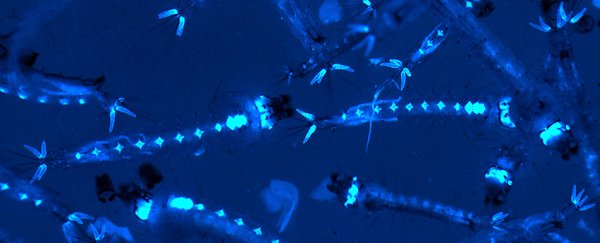In the annals of deadly diseases, few have plagued humankind as viciously as malaria.
In ancient times, Hippocrates attributed malarial fevers to bad air. At one point, the Roman Empire directed those suffering from fever to wear amulets inscribed with "abracadabra" to ward off the disease.
Today, bed nets and insecticides help control the mosquito-borne disease transmission, and drugs prevent infection or blunt malaria's symptoms.
But the disease continues to take its toll. In 2015, there were roughly 212 million cases of malaria and 429,000 deaths. And the disease has become increasingly resistant to drugs.
In recent years, one new tool - genetic modification - has appeared especially promising.
Two studies published Thursday in the journal Science illustrate the potential of genetic engineering for fighting the disease. Both studies were conducted at Johns Hopkins University's Malaria Research Institute.
Malaria is caused by a parasite that lives in the mosquito's gut and infects humans when the mosquito bites.
The first study focused on whether mosquitoes that have been genetically modified to be more resistant to the malaria-causing parasite would become weaker and less able to mate and breed.
If modified mosquitoes are going to be used against malaria, the transformed mosquitoes must be as fit as wild ones and able to pass on their genetic modification in large scale to future generations.
The study, led by mosquito vector biologist George Dimopoulos, found that one type of genetically modified mosquito not only bred well, but became more attractive to normal mosquitoes.
Dimopoulos took a group of genetically modified mosquitoes and a group of wild normal mosquitoes and locked them up together. To his surprise, the normal male mosquitoes preferred the genetically modified females, while the genetically modified males went wild over the normal females.
Those mating preferences meant that within one generation, the mosquito population was becoming 90 percent genetically modified.
"We found the modification was changing the microbiome and bacteria of the genetically modified mosquitoes," Dimopoulos said. "It made them smell different, better to their mates."
The results suggest the genetically modified mosquitoes would not just thrive but could possibly drive their genetic immunity to the malaria parasite into mosquito populations to which they are introduced.
Some day in the future, in order to reduce malaria in especially hard-hit areas of Africa or Asia, we may be able to simply release such genetically modified mosquitoes into the wild and they would spread their immunity.
The biggest concern about such an approach, as it is with all applications of genetic modification - is the specter of unintended consequences.
Some sceptics worry whether the genetically modified mosquitoes could alter the insects' behavior or somehow trigger other changes or mutations in other animals within the mosquitoes' environment.
The second study published Thursday uses genetic modification of bacteria found inside mosquitoes to fight malaria. Researchers genetically modified a type of bacteria, which caused it to secrete a substance inside the mosquitoes' gut that kills off the malaria-causing parasite before it can develop properly.
The researchers, led by biologist Marcelo Jacobs-Lorena, had been working for five years on a way to use genetically modified bacteria against malaria.
Early on in their work, researchers struggled to find a way by which the genetically modified bacteria could be handed down to the offspring of the treated mosquitoes.
Through happenstance, while dissecting the bodies of mosquitoes during earlier attempts, they found a type of bacteria that consistently wormed its way into the ovaries of female mosquitoes and the reproductive glands of male mosquitoes in addition to the mosquito's gut.
Because of that placement in the reproductive organs, the genetically modified versions of the bacteria automatically spread to offspring in generation after generation, the researchers found.
The next step for both approaches - the genetically modified mosquitoes and bacteria - is to test if they work outside the lab in conditions simulating nature.
Johns Hopkins has built a "mosquito house" research facility in Zambia designed specifically for such experiments.
"It's like a greenhouse but instead of glass, it's covered with nets to keep the mosquitoes inside," Jacobs-Lorena said.
But the researchers must first convince the Zambian government to allow their genetically modified subjects into its borders. Zambian leaders have never dealt with genetically modified organisms before, not even plants, Jacobs-Lorena noted.
"It's taking some time to get approval."
2017 © The Washington Post
This article was originally published by The Washington Post.
